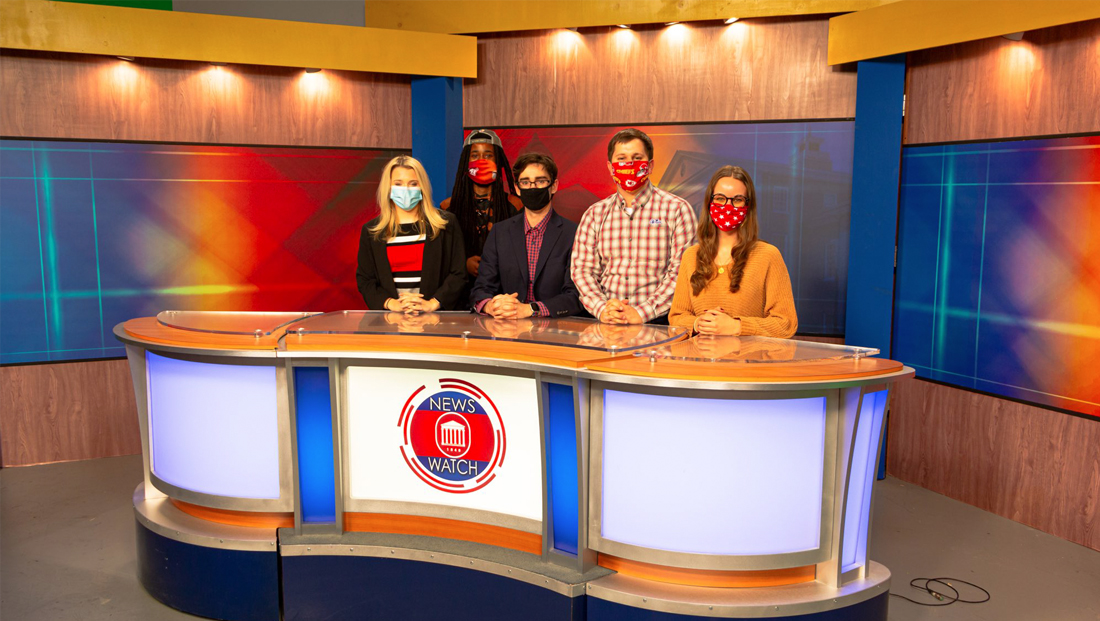Two former FX sets are now helping to educate new TV pros

Subscribe to NCS for the latest news, project case studies and product announcements in broadcast technology, creative design and engineering delivered to your inbox.
Two retired sets created by FX Design Group have found new lives — one of them now in its second reimagining — helping to train the next round of broadcast journalism and production professionals.
WREG, Nexstar’s CBS affiliate in Memphis, Tennessee, recently donated its set to the University of Mississippi, which is part of the market’s reach.
The station donated its old anchor desk, replaced with a new set in October 2020, to “Ole Miss NewsWatch,” the student-run newscast at the university.
While the station’s set walls were not relocated to Oxford, Mississippi, the program was able to integrate the desk with its existing three-walled set with printed graphics, wood-toned elements, blue columns and yellow headers.
Meanwhile, an older set from KVUE in Austin, Texas, owned by Tegna, has entered its second round of use for a local high school.

Back in 2017, Cedar Park High School teacher and broadcast adviser Anthony Garcia made arrangements for KVUE’s old home, also originally designed by FX, to become part of its educational broadcasting program, according to a post on LinkedIn.
The program successfully took apart the old set at the KVUE studios and moved it to the second floor of the school in nearby Cedar Park, Texas. Initially, limited funds were available to update the set.
Cedar Park had to remove the backlit duratrans because they sported KVUE branding and opted to replace them with faux off-white brick. The faux stacked stone running along the knee wall was also painted dark gray.
A small monitor was also added camera center behind the desk.

The school unveiled a new look for the set earlier in 2023, including updating the faux stacked stone and installing a 2×3 video wall behind the anchor desk along with new, darker side backgrounds for “The Wolfcast.”
Garcia noted that when he happened to see that KVUE was prepping for a new set back in 2017, he “cold called” the station and asked what plans it had for the old set.
He was basically told “if you can take it away, it’s yours.”
Stations often donate old sets to broadcast journalism programs at schools and universities, though the challenges and cost of relocating them can often be substantial.
Unfortunately this often means that old sets are simply removed and discarded, though donating just an anchor desk is often an easier way to help out an educational program because they can be easier to transport.
Anchor desks also tend to be very expensive compared to the overall scale of the set and, ironically, often end up getting relatively little time on-air.
That said, anchor desks are obviously helpful for anchors to keep scripts or tablets on as well as give them access to editorial software and return and feed monitors hidden under the desktop. They also can be a convenient way to “hide” mic and IFB hookups and even printers.
Some TV stations hold onto old sets and repurpose them for other productions, such as sports or lifestyle shows.
Finding an old set for your school
Educational institutions looking for old sets from local stations can try reaching out to someone at the station.
This can be timed effective if a station has had its set for a while, meaning it could be primed to get a new one in the near future. If one isn’t immediately available, institutions could ask to be kept in mind for any donations in the future.
Even better, organizations with journalism programs can consider ways to build relationships with local stations — whether in the form of taking tours of the station, having a mentorship or internship program or even having students work as production assistants. Having an existing connection with a station is a great way to ensure your program is top of mind when a set donation might be available.
Another clue that a set may be available soon can be if a station makes an on-air announcement or moves to a temporary setup, though sometimes this is done for other reason other than a new set, such as floor replacements, lighting updates or other maintenance.
Some stations opt to ship parts of their old set, including anchor desks, to a sister station, which would mean it wouldn’t be available for a school, unfortunately.
In some cases, if a station opts to redo the same (or only) studio used for news production, it is often too late to ask once a new set debuts since most of the scenery could have been removed and discarded by then. Stations that swap studios are more likely to still have set pieces around even after the debut of a new one.
Publications like NewscastStudio don’t actively track what stations are doing with old sets.
Keep in mind there may be some costs involved in acquiring an old set or anchor desk from a station, including updating printed graphics to remove station branding to freight or delivery expenses. In general, the farther away the station is from your facility, the more costly it will be to relocate.
If you’re looking for used LED panels and video walls, these can be a bit harder to come by. In many cases, stations purchase these units knowing their specific lifecycles and may repurpose them in the new set or for another use if they can still be used.
Anything being discarded outright could end up being near the end of its life and therefore not have much practical use.
Even if a school is able to snag an unwanted video wall that still works, it still require more advanced software and hardware in order to feed content to them. There are also expenses such as calibration and integration that schools would need to plan for.
Some video walls also need to be left on 24 hours a day per manufacturer recommendations, which could increase electrical bills.
All that said, there has been at least once case where a station decided to move and donate not just a set but the entire station to an educational institution.
Subscribe to NCS for the latest news, project case studies and product announcements in broadcast technology, creative design and engineering delivered to your inbox.





tags
anchor desks, Austin, Education Production, educational, FX Design Group, KVUE, memphis, Nexstar Media Group, Tegna, Video Walls, wreg
categories
Broadcast Industry News, Featured, Local News, Schools, Set Design, Video Walls